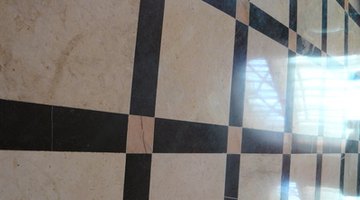Vintage '50s Flooring Styles
In the 1950s, modernism became fashionable and interior design incorporated abstract and geometric patterns and interesting color combinations. A popular look for a home was the American Diner style, with black-and-white floor tiles and bubblegum-colored surroundings. The sleek designer look, with modernistic furniture and textiles, was also popular. Flooring was often very colorful and patterned, and many people covered walls and ceilings with wallpaper in matching colors and patterns.
Floor Coverings

Until the mid-20th Century, most houses had wooden floors throughout, but with the improvement of materials such as vinyl and synthetic carpet fibers, other types of flooring became common. Vinyl tiles or carpets were often laid over a concrete floor surface. Interior decorators and homeowners often updated wooden floors by covering them with carpet or vinyl tiles.
Color Palettes
The color palette changed throughout the 1950s. At first, gray, maroon or burgundy and green color schemes were popular for interior design and flooring. Later in the decade, people started to embrace brighter pinks with contrasting black and white. Pastel colors were popular for kitchen interiors and a kitchen with pink floor tiles and matching cabinets was very fashionable. Other popular pastel colors were yellow and aquamarine.
Whimsical Patterns
1950s homeowners would often opt for a checkerboard vinyl floor in red and white, black and white or yellow and white. Brown floors with a bright yellow block pattern were also popular. Striped candy-cane patterns were often used in kitchens. Flooring companies like Armstrong and Goodyear sold speckled floor tiles in a wide color range, including grays, browns and greens. Floor tiles were often laid in diagonal, geometrical patterns, inspired by Aztec art.
New Materials
Rolled linoleum flooring was popular in North America. Vinyl tiles were an inexpensive flooring choice and were often made from asbestos, which was considered a durable material at the time. Cork floor tiles originated in the 1950s, and Armstrong offered many cork flooring designs. Cotton rugs were often used, either for the whole floor surface or scatter rugs. The 1950s also saw the creation of an innovative design: a reversible cotton rug, tufted and looped on both sides to allow double use and longer wear.
References
Writer Bio
Virtually growing up in a computer repair shop, Naomi Bolton has held a passion for as long as she can remember. After earning a diploma through a four year course in graphic design from Cibap College, Bolton launched her own photography business. Her work has been featured on Blinklist, Gameramble and many others.
Photo Credits
- Marmor Floor image by Sundaysdinner from Fotolia.com
More Articles



